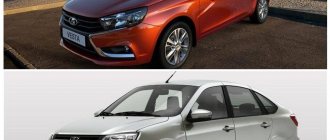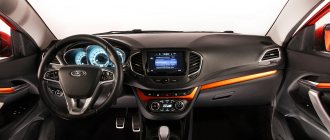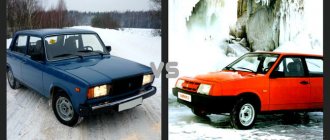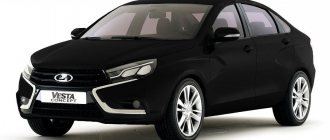Technical features of the machines
Lada Vesta and Lada Kalina
Car Lada Vesta
Before purchasing a domestic car, a car enthusiast asks himself what is better than Lada Vesta or Lada Kalina. Comparison of two cars is made according to the following parameters:
- Appearance and body;
- Power unit;
- Transmission and chassis;
- Specifications;
- Interior and completeness;
- Controllability.
What both cars have in common is that they are good budget cars.
1. Geometric cross-country ability of Lada Vesta and Kalina Cross
— a set of parameters that affect the ability to move unhindered in rough terrain. Such parameters include ground clearance, departure and approach angles, ramp angle, and overhang size.
Ground clearance declared by the manufacturer: 183 and 178 - a difference of 5 mm in favor of the Cross, it would seem bullshit.
Dimensions of the car from the official Lada website in pictures:
As we can see from them, the Cross is both shorter and narrower, and the base length is shorter, and the overhangs are also smaller. But especially the total superiority in the base - 16 cm!!
We took measurements on the bumper; there is no way to measure protection for our collective farm test.
255 mm in front along the lower edge of the Cross' bumper covered with an overlay.
Vesta has almost the same 250 mm to the painted bumper. The angle seems higher, so it may be a little smaller - but in general this is not important, anyway, this was not done on calibrated surfaces, no one checked the pressure in the wheels, and so on. The main thing is to understand the order of numbers.
Let's go further - we measured the distance from the wheel to the bumper.
Cross:
Apparently Vesta is still a little lower:
Next we moved on to more complex, and probably less accurate measurements: we took the center of the tire under the bumper and, using the handle of a shovel, which was along the edge of the bumper, took the distance.
Cross:
Vesta:
11 centimeters of just the length of the front bumper is a lot for geometric cross-country ability, Vesta is a minus.
We go to the sills, measure in the area of the B-pillar - the Cross sills are covered with practical unpainted plastic.
Vesta’s is different - the power element of the bottom is painted and it is lower.
Cross rear overhang:
The rear overhang of Vesta is 6 cm longer:
Under the rear bumper of the Cross they measured as much as 38 cm, again, unpainted plastic and a trim that can be changed separately. But the most important thing is that the distance to the rear beam is very large and along its entire length it is almost straight, and the spare wheel niche and muffler are high and do not stick out.
On Vesta it is smaller (34 cm), but the main problem is that the beam is lower, and the spring cups protrude much lower than it itself - on hard things it can be damaged. The muffler also protrudes more strongly and is located lower, then Vesta demonstrated this by cutting off a hillock with the muffler, where Cross passed without noticing.
We waited for everyone while we shamanized with the roulette, the Tuareg especially warmed the soul if something went wrong))
Packages and additional equipment
- Metallic paint coating RUB 12,000. Paintwork “Metallic grey-beige Carthage” RUB 18,000. Hood deflector RUB 3,743 Set of door deflectors RUB 2,690. Set of door sills with model name RUB 3,091. Interior carpets from RUB 2,506. Trunk net RUB 958 Carpet in the trunk RUB 2,492. Armrest RUR 9,226 LED flashlight with LADA logo 527 rub. Crankcase protection RUB 2,755 Set of front and rear fender liners with sound insulation RUB 4,655. Rear wheel mudguards RUB 1,353. Parking assistance system from RUB 2,214. Rear bumper trim RUB 2,679. Radiator protection frame RUB 2,270. Universal trunk loading carpet RUB 2,404. Car cover RUB 6,073. Set of covers for storing wheels RUB 3,538. Trunk assembly RUB 7,786. Towbar control unit RUB 2,884. Towbar with installation kit RUB 6,825. Trunk organizer with warning triangle RUB 1,708. Car compressor RUB 1,419 Security system with two-way communication from RUB 7,000. Security and telematics system from RUB 6,678. Steering shaft lock RUB 12,802. MPU Garant Consul 11,250 rub. Motorist kit from RUB 2,100. Multimedia center DVM 2117 iQ with Navitel software RUB 35,112. Pioneer passive cabinet subwoofer RUB 6,936. Combo device: DVR + radar detector + GPS camera informant RUB 13,917. Hidden video recorder RUB 15,369. Telematic system LADA Connect RUB 29,990. Car radio from RUB 8,233.
Is Kalina-2 good?
What do you like about a car worth 7 thousand conventional units? It warms up well in winter, the stove is simply thermonuclear! A weak air conditioner that does its job, but is not available in all trim levels. On top of the “dashboard” there is a convenient drawer with a lid.
There is a place for a mobile phone if the radio is simple without a screen. And that's what she is. The plastic is cheap and hard, but for the money it's ok. Essentially, what is soft plastic for? Why not lie on it?! There are no big complaints about the car.
There are several minor shortcomings. The knee sometimes rests against the console, sometimes causing bruises. It depends on the driver's build, but it's fine for me. The steering column switches are Soviet, they work a little noisily, but do not break. Convenient hazard warning button, illuminated glove compartment, making it easy to find something in it in the dark.
Lada Vesta Sport 2019-2020 owner reviews
- Review
- Prices
- Characteristics
- Photo
- Video
- Reviews
All the disadvantages of Lada Vesta Sport 2019-2020
➖ Manual transmission (6th gear missing) ➖ Creaking suspension / brakes
pros
➕ Design ➕ Handling ➕ Suspension
The advantages and disadvantages of the new Lada Vesta Sport 2019-2020 model in a new body were identified based on reviews from real owners. More detailed pros and cons of the Lada Vesta Sport 1.8 with mechanics can be found in the stories below.
Owner reviews
I signed up for a test drive out of curiosity, drove it and realized that I wanted and could. And took! A car is bought primarily with the eyes, and I really like it - balanced, lively, interesting, individual. People turn to look at her and it’s nice.
There were many cars, including turbo VAG, namely Octavia 180-horsepower with DSG and Citroen DS4 with turbo. Yes, it’s not a Skoda in terms of dynamics and equipment (I had almost the maximum), but I want to drive it. How does she steer!
For me, the Lada was a revelation, everything was thought out, as Sergei Stilavin said - a feeling of factory tuning, high-quality and thoughtful. And this is the complete truth!
…A month and 1,000 kilometers have passed, and certain conclusions can be drawn. The car is being run in, so I don’t use it above 110 km/h and 3,500 rpm. In fact, it’s a surprisingly pleasant car, the handling is excellent, the engine is sufficient, and no flaws were found in the ergonomics. Have you ever regretted buying Vesta?
Review of Lada Vesta Sport 1.8 manual transmission 2022
Video review
First impressions... How cool it is! I'm enjoying myself! After the soft, imposing Lexus RX400h in such a knocked down, elastic box! The steering wheel is here for beauty! It feels like I turn it a maximum of 3 degrees per trip in each direction, it’s super clear and informative. The brakes are great, but maybe just new.
My first thought was: “if this suspension doesn’t get loose over time and start rattling, then this is the best thing I’ve ever driven.” Excellent road holding and absorbs potholes. Sometimes it seems like “it’s about to hit the wheel,” but nothing happens! My Lexus and Rio are not close in this regard.
Offer for sale
No offers from car dealerships
New cars on AUTO.RIA
Cookies “For the convenience of using the site and all services, we use cookies.
To learn about types of cookies
and configure them,
click "Customize" or check out
"Cookie Policy"
.
I accept all settings
Cookie settings “We (ARS ONLINE OÜ) use cookies that are required for the operation of our website and services, based on legitimate interest. Also, with your consent, we would like to install optional analytical cookies on your device to remember data about browsing and use of services, as well as marketing cookies that will help us understand which services and products interest users most.
By turning on these cookies, you help improve our services and products. Read more about cookies in our Cookies Policy. We install mandatory cookies in any case. Below you can choose whether or not to allow us to install optional cookies."
Save
Controllability
Handling has become better. Thanks to the steering rack, it has become shorter, and the steering wheel can now be turned from one stop to another in just 3 turns, and not 4, as before. The steering wheel itself in the new car is also attached differently. Due to all this, the sensitivity of control and the rigidity of the steering system have increased. The car reacts faster to the driver’s actions, and it has become easier to avoid obstacles and bumps on the roadway.
In addition, one cannot help but pay attention to the car’s new anti-lock braking system, which in the “luxury” configuration is also supplemented with a stabilization program. The design of the brake system has changed somewhat - some of the parts are now imported.
Security and systems
- Driver's airbag Front passenger's airbag with deactivation function ISOFIX child seat anchors Child locking the rear doors Automatic door locking when driving Automatic emergency braking activation of the hazard warning lights Automatic door unlocking and collision warning activation of the hazard warning lights Immobilizer Security alarm ERA Emergency Alert System -GLONASS Anti-lock braking system with electronic brake force distribution (ABS, EBD) Brake Assist System (BAS) Electronic Stability Control (ESC) with shutdown function Traction Control System (TCS) Hill Start Assist (HSA) Electric power steering Seat belt adjustment front seat height
Lada Granta Cross: what is better than the previous Kalina Cross?
Having transformed from Kalina to Granta, the station wagon with the Cross prefix has changed a lot in appearance. But that’s not the main thing!
With this station wagon, AvtoVAZ formally completes the reform of the Granta family. However, you can only partially call the car new. Its complex physiognomy, borrowed from Vesta, was shown to us last fall, and was tried on by Kalina Cross almost five years ago
Why such wheels?
It’s strange, of course, but the engineers sacrificed comfort to improve the appearance of their crossover, with which they associate their new product. Take a look at the same Duster or Creta, the profile on the factory tires is higher. On Vesta they managed to fit 205/50/17. It’s beautiful, no doubt about it, but there’s no practicality, especially for this “CROSS” console. Of course, handling on the highway will be better with such wheels, but this is not what you should expect from a crossover, which AvtoVAZ wants to consider the Sw Cross to be.
In any case, even if I decide to buy this beauty, for the winter I will put R15 wheels on it with the highest possible profile that will fit. Even if we consider the financial investment, putting on R15 winter tires will cost much less than R17.
Exterior
Initially, Lada Kalina was considered exclusively as a “workhorse”. Consequently, the attitude towards design was largely characterized by the residual principle. They say that this is not the main thing for such a machine. But after the restyling, the model began to look much more lively and aggressive.
Initially, the Lada Kalina was a simple car. Rather, even too simple.
The front bumper is decorated with a huge air intake supporting a small radiator grille. And under the spectacular headlights there are small foglights located in massive seats.
The new Kalina looks much more interesting from the front!
However, there are an order of magnitude fewer changes in the profile. The same modest and proportional doors, a round tank flap with a recess for opening, front fenders and so on. Perhaps the changes affected only the rims and rear fenders.
On the side, other than the different rear wings and rims, no changes are observed.
The situation is similar with regard to the stern. There are no fundamental changes observed, with the exception of the rear bumper, which has become more massive and powerful, and has also acquired new reflectors and a trim at the bottom.
At the rear, the changes are more noticeable, but they are not fundamental.
The image of Lada Vesta is fundamentally different. She was not a nondescript machine, to which they later tried to instill pseudo-aggressive features. Initially, Lada Vesta was created as a landmark and expressive car - the first representative of AvtoVAZ’s new corporate style. That’s why it looks more harmonious – the headlights, chrome, air intake, foglights, “X” lines and other elements of the front end combine perfectly.
Vesta's front end is much more harmonious.
From the side the impression is the same. A solid, complete product, with logical lines and transitions, stylish rims and considerable ground clearance.
The ground clearance of the Lada Vesta can be the envy of some crossovers.
And the food didn’t disappoint. The chopped lines of the stops are impressive, especially against the background of a modest bumper and a proportional trunk lid, decorated with large letters of the brand name.
Vesta looks great from behind!
Advantages and disadvantages of Vesta
Lada Vesta car However, Vesta is a pretty good car, which has a number of advantages over Kalina. Firstly, this is a more spacious Lada:
| Vesta | Kalina |
| Length 4410 mm | Length 4104 mm |
| Width 1764 mm | Width 1700 mm |
| Height 1497 mm | Height 1560 mm |
| Ground clearance 178 | Ground clearance 160 |
In addition to the differences in the dimensions of the car, when purchasing Vesta you get:
- Original modern appearance. Which stands out for its species among its classmates;
- Comfortable and cozy interior with modern equipment and the necessary set of accessories;
- Spacious trunk;
- Dynamic, economical and safe car.
Driving such a car is a pleasure, and its expressive appearance adds charisma to its owner. The only advantage of the Lada Kalina is its lower cost. But not everything is good in Vesta, there are disadvantages:
- The brake pedal is higher than the gas pedal, everyone is used to them being at the same level;
- The display and radio are not recessed into the front panel, which leads to the screen being exposed to bright light and the readings are difficult to read;
- More than strange control of the on-board computer. But you get used to it pretty quickly.
On YouTube, follow the link to see a comparison of two Lada cars.
After the Lada Vesta entered the market, many became convinced that public interest in other AvtoVAZ models would soon fade away altogether. But this is not true, because other cars are produced and sold as before. However, for them the new product has become a powerful competitor, and a considerable number of potential buyers are thinking about the opportunity to save up a little more and purchase a new sedan. A significant part of them initially targeted the Lada Kalina.
Will Kalina become a serious rival to Lada Vesta at a lower price?
Advantages and disadvantages
Among the advantages of Kalina 2, both testers and new car owners primarily highlight the original design. For decades, it was believed that beautiful cars are made only abroad, and the Russian auto industry lagged behind in this regard by at least 10–15 years, but now everything is not so clear.
It is worth noting the increased engine power and a different quality of the dashboard with a more convenient location of sensors and scales. An airbag is now even included as standard. The reliable suspension now has an increased service life and the front struts are now much more durable than those of most other domestic cars.
Now about the disadvantages of the new Kalina 2. The disadvantages include, first of all, the too noisy and already quite outdated eight-valve engine (in the “standard” configuration), then the hydraulic adjustment of the headlights (other cars have only had electric adjustment for a long time) and the lack on the dashboard sensor indicating the coolant temperature.
In addition, unfortunately, the quality of the Russian assembly is still “lame” - some small parts may be screwed carelessly or not tightly enough, and in some examples of the car you can hear the doors squeaking against the body while driving.
Packages and additional equipment
- Additional payment for metallic body painting is RUB 6,000. Alloy disc from RUB 3,767. Wheel cap from 104 rub. Set of door deflectors RUB 1,487. Hood deflector RUB 1,650. Interior carpets from RUB 2,249. Armrest for cars RUR 6,954 LED flashlight with LADA logo from RUB 504. Crankcase protection (original) RUB 1,388. Set of mudguards from RUB 193. Set of front and rear fender liners with sound insulation RUB 2,912. Parking assistance system (4 sensors) from RUB 2,118. Parking assistance system (8 sensors) from RUB 7,995. Trim for the trunk opening RUB 1,244. Set of door sills with model name RUB 1,602. Set of covers for storing wheels R13-R16 RUB 3,286. Radiator protection frame from RUB 1,897. Universal trunk loading carpet RUB 2,301. Complete trunk from RUB 4,040. Aerodynamic roof box (gray embossing) RUB 17,287 Mount on the trunk for transporting skis (4 pairs) and snowboards (2 pairs) RUB 3,115. Mount on the trunk for transporting a bicycle (aluminum) RUB 3,024. Cargo basket 1200x700 (aluminum) RUB 4,788. Trunk organizer with warning triangle RUB 1,587. Electrical wiring kits are required to connect the towbar socket RUB 615. Car compressor RUB 1,358 Security system with two-way communication from RUB 7,510. Security and telematics system from RUB 7,000. Anti-theft lock Garant Bastion 2024 T Single RUB 12,500 Protection of the standard ignition switch Guarantor from RUB 7,403. Motorist kit from RUB 1,496. Telematics system from RUB 8,455. Car radio from RUB 4,589. Acoustic system from RUB 2,893. Passive cabinet subwoofer RUB 6,450. Combo device 3 in 1 ACV GX-7000 RUB 12,943 Hidden video recorder AVILINE DVR-B RUB 14,707.
The information on this site does not constitute an offer as defined by the provisions of Articles 435 and 437 of the Civil Code of the Russian Federation. Information about prices and vehicle configurations indicated on the website is for informational purposes only. The prices indicated may differ from the actual prices of authorized official dealers and other car dealerships.
Specifications
Engines
Now the Lada Vesta is offered with only one engine, but this meager line will be expanded over time and there will be four engines. Kalina is equipped with three engines.
The Lada Vesta is equipped with a 106-horsepower, injection domestic power unit. At around 5,800 rpm it produces maximum output, and its peak thrust, which reaches 148 Nm, occurs at 4,200 rpm. With it, Vesta accelerates to hundreds in 11.8 seconds, giving a maximum of 178 km/h. It is noteworthy that this engine is the top one for the Lada Kalina, and no changes are made to it. However, the hatchback with it is more dynamic than the Vesta - changing hundreds on it takes 11 seconds, and the maximum speed is 3 km/h more (181 km/h). With automatic transmissions the situation is somewhat different. In this case, Vesta has, albeit a small, advantage in both respects - acceleration in 12.5 seconds. versus 12.9 sec. and a peak speed of 178 km/h versus 175 km/h.
The 106-horsepower Russian engine is installed on both Vesta and Kalina.
Another Lada Kalina engine is a 98-horsepower, 1.6-liter unit. To get all l. With. it needs to be revved up to 5,600 rpm, and at 4,000 rpm the engine produces its greatest thrust of 145 Nm of torque. A special feature of the configuration is that the power unit is combined exclusively with an automatic transmission, which affects the dynamics of the car - Kalina manages to reach a hundred in only 13.8 seconds, with a top speed of 171 km/h.
Kalina's 98-horsepower 16-valve engine is coupled exclusively with automatic transmission.
The third, and weakest, Lada Kalina engine is an 87-horsepower, 8-valve unit. This is a budget version of the model. Its power is small and achievable at 5,100 rpm, but the torque is quite decent and reaches 140 Nm at 3,800 rpm. Dynamic characteristics are not great, but 12.2 sec. for a set of hundreds at 168 km/h maximum do not look so bad. The same engine is planned to be installed on the Lada Vesta, which will reduce the price of the sedan and make it even more competitive.
This budget engine produces 87 hp. pp., they intend to install it on the Lada Vesta.
In addition, we can soon expect the appearance under the hood of the Lada Vesta of a 110-horsepower HR16DE-H4M engine, which Alliance Renault Nissan shared with AvtoVAZ, and a 1.8-liter domestic power unit. The latter is the latest development of the Russian concern and is already installed on the X-Ray model, as well as a foreign engine. Soon they will appear under the hood of the Lada Vesta.
Lada Vesta will also receive a motor from the Alliance.
Transmissions
Both models offer three types of gearboxes. However, AvtoVAZ’s approach in this regard is different. The Lada Vesta has a pair of 5-speed manual gearboxes - the French type JH3 510 and the Russian MT type VAZ-2180. It is noteworthy that the latter has been modernized in order to keep up with the foreign checkpoint in terms of accuracy of operation. To do this, the “mechanics” from Priora were taken and seriously redesigned, including the use of a different secondary shaft (reinforced), synchronizers and a switching module from the German brand Schaeffler. And the oil volume has been reduced by 30%. All this had a beneficial effect on the clarity and quality of work, reduced background noise and eliminated other disadvantages of the box.
The mechanical transmission of the Lada Vesta works clearly and smoothly!
The Lada Kalina has only one 5-speed manual transmission - the VAZ-2181 type. In general, it is not bad, but in performance it is inferior to Vesta’s transmissions. The lever vibrates, switching is not so clear, and background noise takes its toll. In general, all the shortcomings that the creators of Vesta struggled with remain.
But Kalina’s gearbox does not have such advantages!
In addition, Vesta and Kalina have the same 5-band robotic gearbox of the AMT-2182 type, created on the basis of a mechanical transmission by adding an electronic control unit and foreign components. In general, it is quite enough for movement. In the city, the shifts are, of course, more noticeable compared to a classic “automatic” with the same number of gears, but the ride turns out to be quite comfortable and convenient. The robot also performs very well on the track. This box is installed on the Lada Vesta in order to reduce the cost, since it is cheaper than an automatic transmission.
The AMT type robot is the same for both models!
But the Lada Kalina has a traditional torque converter type JF414E from the Japanese corporation JATCO. Despite the fact that the automatic transmission is only 4-band, in the city it fully justifies itself, although on the highway the absence of 5th speed is still noticeable.
The Japanese 4-band automatic transmission from JATCO performs well, especially in the city.
Chassis
For the B segment, both cars have a standard suspension layout. The front axle has MacPherson struts, while a torsion beam is mounted at the rear.
The chassis of Kalina and Vesta are structurally identical - beam and MacPherson struts.
However, the settings of the shock absorbers and other components are different, which affects the handling. Lada Vesta in this regard is more collected and understandable. It steers sharper, turns more enthusiastically, rolls less, and there is almost no wave swing. But in Kalina all this is felt to one degree or another.
However, the handling of the Lada Vesta is noticeably better!
Comparison of parameters
At the first glance at her appearance, Vesta’s prestige and swiftness immediately catches the eye, which makes a favorable impression. And the appearance of Kalina is associated with retro; it benefits from the fact that there is a greater variety of body options in the model range. Nowadays, swiftness and elegance of the body are in fashion, which is confirmed by the appearance of Vesta. The presence of a subframe gives greater rigidity to the body. Technical features of the machines
Power point
Both cars have the same power units. The exception is the Vesta version, which has a Nissan engine installed. When comparing the gearbox, Vesta also retains the advantage. There are two options: the French type JH3 510 and the Russian one, deeply modernized from the Priora VAZ-2180. This allowed not only to reduce noise, but also to improve the quality of work and the clarity of gear shifting.
Her opponent has only one option, such as the VAZ-2181. This is a manual 5 speed gearbox. However, both machines have the same robotic boxes of the AMT-2182 type. Vesta does not install an automatic transmission; it is much more expensive than a robot, but the opponent has a 4-range automatic transmission. For the city it is quite enough, but on the highway you can feel the absence of 5th gear.
Suspension
Both cars have the same suspension installed on cars of this class. The differences are in the settings. Therefore, unlike the Kalina, the Lada has better handling, has little roll when cornering and virtually no wave buildup. It holds the track perfectly, there is no “walking”, which makes it easier for the driver to travel long distances.
Vesta has a stiffer suspension than Kalina, which is a big plus if you drive on country roads and poorly paved roads. And the high ground clearance adds to its advantages. But speed bumps must be passed at lower speeds. Otherwise, a rear bounce is inevitable, but without the usual hard impact of the rear suspension.
Interior
Lada Vesta and Lada Kalina In order to compare the Lada Vesta and Lada Kalina in terms of interior, it is worth noting that the former has a longer and wider body. This means that there is more space in the cabin, and the driver and passengers will be more comfortable when driving in the car. If we compare the seats for rear passengers, then in Kalina it is clearly not enough. And the seats in Vesta are much more comfortable. My back feels great when riding long distances.
There is no aching pain from uncomfortable sitting. The driver's seat in Vesta has a greater number of adjustments, and when adjusting the steering wheel not only in height, but also horizontally, it adds comfort. Now the driver has the opportunity to adjust his workplace to suit any person’s height.
Noise insulation
The Vesta's interior is quite quiet, only the noise of the wheels is heard, and with the windows closed, passing cars can only be heard at a minimum distance. It is much noisier in Kalina; for a comfortable ride it is advisable to do sound insulation. The interior equipment and the location of all kinds of buttons are much clearer and more convenient in Vesta, and such a small thing as mirrors in the sun visors will appeal to women.
Price difference and handling
If we compare the prices of basic models, the difference in price will be approximately 70,000 rubles, but when buying Vesta, we get a modern and equipped car. With equipment that meets all the requirements of the time.
Comparison of Lada Vesta and Lada Kalina in road stability and cornering is not in favor of the latter. On the first one you just drive and don’t think about it when cornering. On the road, you don’t need to steer it and be afraid of significant rolls when turning, like Kalina’s. So whether to choose Lada Vesta or Lada Kalina, this question must be answered by the buyer.
What to buy anyway
Will your purchase be a Vesta or a new Kalina under the fresh name Granta when the car has to be changed? Everyone considers this question for themselves. If you drive mainly around the city, where it is difficult to park, then Kalina is better. If you need a car for long roads, then Vesta will be optimal.
Of course, Vesta looks cooler today, and young people are unlikely to buy Granta if they have the money. It is made at a new technical level, equipped with all possible bells and whistles and functions that some foreign cars do not have. Those who have already bought Kalina drive it and are also happy. After all, it consumes less gasoline. For example, on the highway, consumption during leisurely driving is 5.3 liters per “hundred”.
And if you drive in the city, then Grant and Kalina have no equal in terms of efficiency! You can’t play around too much in a Lada Vesta; as they say, you’ll end up out of the woodwork quickly. In terms of parking space, I think everyone understands which car is better.
In general, everyone has their own choice. For this purpose, the plant produces different types of machines so that you can choose. It all depends on the purpose of the car and the needs of the car owner. Each of the models under consideration has its own pros and cons. There are many owners of both brands who will diligently prove that their car is better than others. And everyone will be right in their own way!
Good day to all readers of my Kalinka!
The question has arisen whether to change Kalina or not. The reason for the hesitation is the condition of the body, namely rust. Repaint with a budget for painting and all spare parts for under 100 k, or exchange for Vesta Cross, Grant station wagon.
I went to the salon today to ask the price. take it for a test drive. The manager at the salon is a good friend of mine, so I got to ride quite a bit. On Vesta Cross drove about 30 km, on Grant about 15-20 km.
So, first things first. The first in line was Vesta Cross with a 1.8 Lux Prestige engine on the mechanics
. Exterior design - 5 points. But, again, it depends on the color. There was no need to force the manager to talk or ask questions, because... I know all these Lada cars like the back of my hand in terms of theory, design, etc. Just general impressions. Handling is awesome, Shumka is also awesome, you can’t feel the speed.
The 1.8 engine doesn't run at all
, nowhere and no way! You can throw tomatoes at me, whatever you want, but I’m not going to refuse these words, because... it is a fact! Just an example. You drive in 4th gear at about 70-80 km/h. You press the gas of a light driver and you don’t feel any acceleration. You press the gas to the floor - nothing changes! No kick, no jerk, no feeling of acceleration. And so on in any mode. Accelerates smoothly. There is no trace of such an explosion as I have on Kalina (21126 stock engine)! It runs somehow only in third gear. 1-2 gears are clearly not for acceleration. We'll talk about this later. The clutch is very light, and therefore there is a complete lack of information content. You don’t feel the moment of starting, you don’t feel the moment of grip when switching, you don’t understand when to release the gas so that there is no over-throttle. Chutos even fried it out of habit. I couldn’t get used to it after 30 km. If I had my car, it would take at least a month to get used to this clutch. But I was pleased with the consumption (not shocked, otherwise everyone writes that it is cosmic) 8.4 liters per 100 km (4 people in the cabin) mixed mode. Gas to the floor not too often.
All facts about Lada Vesta Sport
Lada Sport, which deals with “hot versions” of Lada, is responsible for several cars in the brand’s model range: Granta Sport, Kalina Sport, Kalina NFR, plus “budget” Light versions. Next up is Vesta Sport. We update the material as news arrives!
The fact that Vesta will have a sports version became known almost certainly from the moment when the concept of the racing Lada Vesta TC1 for the WTCC world championship was shown at MIAS 2014 in 2014. It was clear that using the well-known and already tested recipe on the Granta and Kalina models, the Lada Sport division would transfer the racing spirit of Vesta into real life. But when this transfer would occur was a complete mystery.
Fans of Lada sports versions had to wait quite a long time for the first fragmentary information: only in February 2016 it became known that Vesta Sport would receive a 1.8 engine, which had just begun to be installed on production Lada Xray hatchbacks. Let us remind you that this new gasoline engine with the VAZ-21179 index was developed by AVTOVAZ specialists, has a variable phase system (VVT) and in the stock version develops 122 hp. With.
Engine and chassis
Obviously, for the sporty Vesta, the engine output had to be increased, because the 136-horsepower Kalina NFR, which by that time was already being produced in small series, could not be more powerful than the hierarchically more representative Vesta. According to the first estimates made by journalists, Vesta Sport should have about 150 hp under the hood. s., but no more, so as not to fall into the next tax class, and later these assumptions were confirmed - by this moment we have “approximate” power figures: 145-150 hp. With.
The gearbox is a manual five-speed Renault JR, exactly the same one installed on regular Vestas - it has a good reserve of torque. It is possible that a different set of gear ratios will be used in the sports version, just as it was done on the Granta Sport, Kalina Sport (and, of course, on the Kalina NFR) - however, for these “younger” models it was not the “renault” one that was modified. , and the VAZ five-speed.
There is no exact data on the dynamics that such a power unit will provide for this car. But we can assume with a fair degree of confidence that the Vesta Sport will be faster than the Kalina NFR, accelerating to 100 km/h in 8.5 seconds.
In February 2016, other details became known about the most powerful Lada, which is preparing to take its place in the lineup. The vehicle's ground clearance will decrease to 133 mm, which is 45 mm less than the standard Vesta. The suspension uses modified shock absorbers (Lada Sport uses different, stiffer ones on all its cars) and springs from the domestic brand Demfi (it is significant that the brand is Lada’s partner in the Russian circuit racing series).
Vesta has front disc brakes and rear drum brakes as standard. For the Vesta Sport version, the size of the front brake discs has been increased from 260 to 286 mm, and at the rear there will now be discs instead of drums. Matching the increased “braking arsenal” is the wheel size – R18 205/40.
Appearance
External attributes of belonging to a sport are complemented by original bumpers and door sills. The first announced body color is the signature color of the Lada Sport Rosneft racing team, bright yellow. Before the appearance of real photos, the Kolesa.ru website published its renderings of the Lada Vesta Sport, and the first unofficial, but real photos of the sports Vesta appeared much later, but it was from them that many of the exterior features were clarified.
Thus, it turned out that the roof of the car, mirror housings and wheel rims are painted black, and the chrome design elements have disappeared from the front part - the Vesta Sport was also black. A spoiler was installed on the trunk lid of the exposed Vesta Sport, the appearance of which, as it turned out later, was not final. Interestingly, the car shown was fitted with 17-inch wheels, which was at odds with earlier reports of R18 wheels.
The fate of the “emphasized” understampings on the sidewalls of the body in the style of the racing Vesta TC1 is still not entirely clear: Vesta Sport had them in those very first photographs, and they also appeared in a later large Vesta Sport photoset. Moreover, it was assumed that the sports Vesta would be shown at MIAS 2016, and that’s what happened - and the “X’s” on the sidewalls of the sports versions of Vesta and X-Ray were also “summed up,” although the body color changed from bright yellow to gray. The wheels are R18 again. According to the Moscow presentation, the appearance of the spoiler on the trunk lid has been clarified - it has become more concise and clearly closer to the production version. And the “boomerangs” on the front end were painted chrome again.
At MIAS 2016, Steve Mattin, the chief designer of Lada and the author of the new style of the domestic brand, spoke about Vesta Sport. At the end of the auto show, AVTOVAZ released a video with this short presentation.
Interior
Initially, it was known that Vesta Sport would have seats with different upholstery, as well as some color accents in the interior design. In the photographs shown in June, we saw the front seats - obviously with a standard frame, but a completely different profile, much more developed lateral support and a two-tone perforated finish - as well as yellow stitching on the seats, gearshift lever and steering wheel, the original braid of which is also supplemented with a zero position mark, also yellow.
In a word, this is a recipe also known to us from the Granta Sport, Kalina Sport, Kalina NFR models. Probably, the interior of the serial Vesta Sport will also include floor mats with the model name printed on them, as well as pedal covers and door sills.
The exact prices, as well as the timing of the appearance of the Lada Vesta Sport, have not yet been announced. As we could see earlier, the surcharge for the “sportiness” of a car of a domestic brand is not so high: in September 2016, the price for a Lada Kalina Sport is 599,000 rubles, and for a “regular” hatchback in a luxury version – 535,800 rubles. This is a difference of 63,200 rubles, and if you refuse a number of premium options, you can get “Sport” for only 551,000 rubles.
Interior
Compared to the original version, the interior of the Lada Kalina has been significantly redesigned. Gone is the combination of black and beige plastic, the awkward shape of the center console, bloated air vents and uncomfortable ergonomics. They worked much more carefully on the new version of the interior - in the center of the dashboard there is a large display, the arrangement of keys and dial controls has become much more convenient and logical, the dashboard has acquired wells and poisonous green backlighting, the upholstery of the door panels and other interior elements have changed slightly. But the revolution did not happen - only the most obvious defects and shortcomings were eliminated in the model.
The interior of the Lada Kalina is not bad. But there is nothing outstanding about it either.
Lada Vesta is different inside. Her salon is designed in a modern style. Smooth transitions and lines of the dashboard, 3-spoke multi-steering wheel, titanium inserts, high-quality assembly, thoughtful ergonomics, a display that fits organically into the composition, comfortable seats and a spacious back row. This set of advantages is more than enough to adequately compete with the segment leaders, and Kalina Veste is not a rival at all!
The interior of the Lada Vesta is much more attractive and functional.
Review of Kalina sedan
The appearance of the Lada Kalina is no different. Comparing photos of the first, only invented models and the car that rolled off the assembly line, it can be argued that the designers and developers did not make any special changes to the exterior of the car. Smooth and smooth contours, a streamlined roof, bumper and headlights are more reminiscent of foreign cars of the 90s. And yet, many car owners, especially women, find the Kalina sedan from AvtoVAZ cute and attractive.
Judging by the external and internal design, car designers tried to make a very compact body and the most spacious interior. The Lada Kalina sedan, according to many critics, looked a little ridiculous and incomprehensible. Therefore, over time, they decided to close the production of this particular model and replace it with the Lada Granta. In the photo, as in reality, you can see some similar features of the Kalina sedan and the Grant, which proves the smooth transition of one model to another.
Appearance
And finally, the body length has become a little larger. This was possible after increasing the wheelbase, which, in turn, made the similarity with the crossover even more obvious.
The lighting equipment, as well as the radiator grille, remained the same as the previous modifications.
Employees of the Volzhsky Automobile Plant note that they were able to largely eliminate the problem associated with poor noise insulation.
The interior has not undergone any special modifications. By and large, everything remains the same as last year’s version of Kalina. However, there are several innovations:
- ISOFIX fastenings appeared;
- The ability to adjust the seat belt tension has been added.
The interior was enlarged due to the overall enlargement of the body.
It is worth noting that the upholstery is now made from new materials. Moreover, the color palette has been significantly expanded. Thanks to this, car owners have the opportunity to individualize the interior decoration as much as possible.
It is also worth noting that the engineers managed to expand the trunk. Its volume is 350 liters, which is not bad. As a result, the Kalina hatchback, in fact, became the first crossover produced in Russia with such a large luggage compartment.











